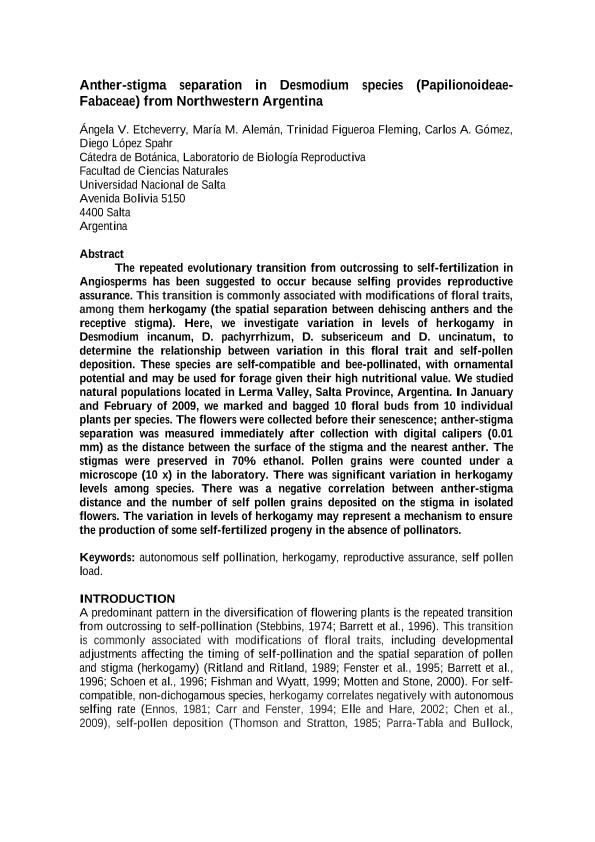Mostrar el registro sencillo del ítem
dc.contributor.author
Etcheverry, A. V.
dc.contributor.author
Alemán, M. M.
dc.contributor.author
Figueroa Fleming, Trinidad

dc.contributor.author
Gómez, C. A.
dc.contributor.author
Lopez Spahr, Diego

dc.date.available
2017-02-16T15:30:22Z
dc.date.issued
2011
dc.identifier.citation
Etcheverry, A. V.; Alemán, M. M.; Figueroa Fleming, Trinidad; Gómez, C. A.; Lopez Spahr, Diego; Anther-stigma separation in Desmodium species (Papilionoideae-Fabaceae) from northwestern Argentina; International Society for Horticultural Science; Acta Horticulturae; 918; -1-2011; 183-188
dc.identifier.issn
0567-7572
dc.identifier.uri
http://hdl.handle.net/11336/13096
dc.description.abstract
The repeated evolutionary transition from outcrossing to self-fertilization in angiosperms has been suggested to occur because selfing provides reproductive assurance. This transition is commonly associated with modifications of floral traits, among them herkogamy (the spatial separation between dehiscing anthers and the receptive stigma). Here, we investigate variation in levels of herkogamy in Desmodium incanum, D. pachyrrhizum, D. subsericeum and D. uncinatum, to determine the relationship between variation in this floral trait and self-pollen deposition. These species are self-compatible and bee-pollinated, with ornamental potential and may be used for forage given their high nutritional value. We studied natural populations located in Lerma Valley, Salta Province, Argentina. In January and February 2009, we marked and bagged 10 floral buds from 10 individual plants per species. The flowers were collected before their senescence; anther-stigma separation was measured immediately after collection with digital calipers (0.01 mm) as the distance between the surface of the stigma and the nearest anther. The stigmas were preserved in 70% ethanol. Pollen grains were counted under a microscope (10×) in the laboratory. There was significant variation in herkogamy levels among species. There was a negative correlation between anther-stigma distance and the number of self-pollen grains deposited on the stigma in isolated flowers. The variation in levels of herkogamy may represent a mechanism to ensure the production of some self-fertilized progeny in the absence of pollinators.
dc.format
application/pdf
dc.language.iso
eng
dc.publisher
International Society for Horticultural Science
dc.rights
info:eu-repo/semantics/openAccess
dc.rights.uri
https://creativecommons.org/licenses/by-nc-sa/2.5/ar/
dc.subject
Autonomous Self-Pollination
dc.subject
Herkogamy
dc.subject
Reproductive Assurance
dc.subject
Self-Pollen Load
dc.subject.classification
Otras Ciencias Biológicas

dc.subject.classification
Ciencias Biológicas

dc.subject.classification
CIENCIAS NATURALES Y EXACTAS

dc.title
Anther-stigma separation in Desmodium species (Papilionoideae-Fabaceae) from northwestern Argentina
dc.type
info:eu-repo/semantics/article
dc.type
info:ar-repo/semantics/artículo
dc.type
info:eu-repo/semantics/publishedVersion
dc.date.updated
2017-02-15T14:54:56Z
dc.identifier.eissn
2406-6168
dc.journal.volume
918
dc.journal.pagination
183-188
dc.journal.pais
Bélgica

dc.journal.ciudad
Leuven
dc.description.fil
Fil: Etcheverry, A. V.. Universidad Nacional de Salta. Facultad de Ciencias Naturales; Argentina
dc.description.fil
Fil: Alemán, M. M.. Universidad Nacional de Salta. Facultad de Ciencias Naturales; Argentina
dc.description.fil
Fil: Figueroa Fleming, Trinidad. Universidad Nacional de Salta. Facultad de Ciencias Naturales; Argentina. Consejo Nacional de Investigaciones Científicas y Técnicas. Centro Científico Tecnológico Salta; Argentina
dc.description.fil
Fil: Gómez, C. A.. Universidad Nacional de Salta. Facultad de Ciencias Naturales; Argentina
dc.description.fil
Fil: Lopez Spahr, Diego. Universidad Nacional de Salta. Facultad de Ciencias Naturales; Argentina. Consejo Nacional de Investigaciones Científicas y Técnicas. Centro Científico Tecnológico Salta; Argentina
dc.journal.title
Acta Horticulturae

dc.relation.alternativeid
info:eu-repo/semantics/altIdentifier/doi/http://dx.doi.org/10.17660/ActaHortic.2011.918.22
dc.relation.alternativeid
info:eu-repo/semantics/altIdentifier/url/http://www.actahort.org/books/918/918_22.htm
Archivos asociados
